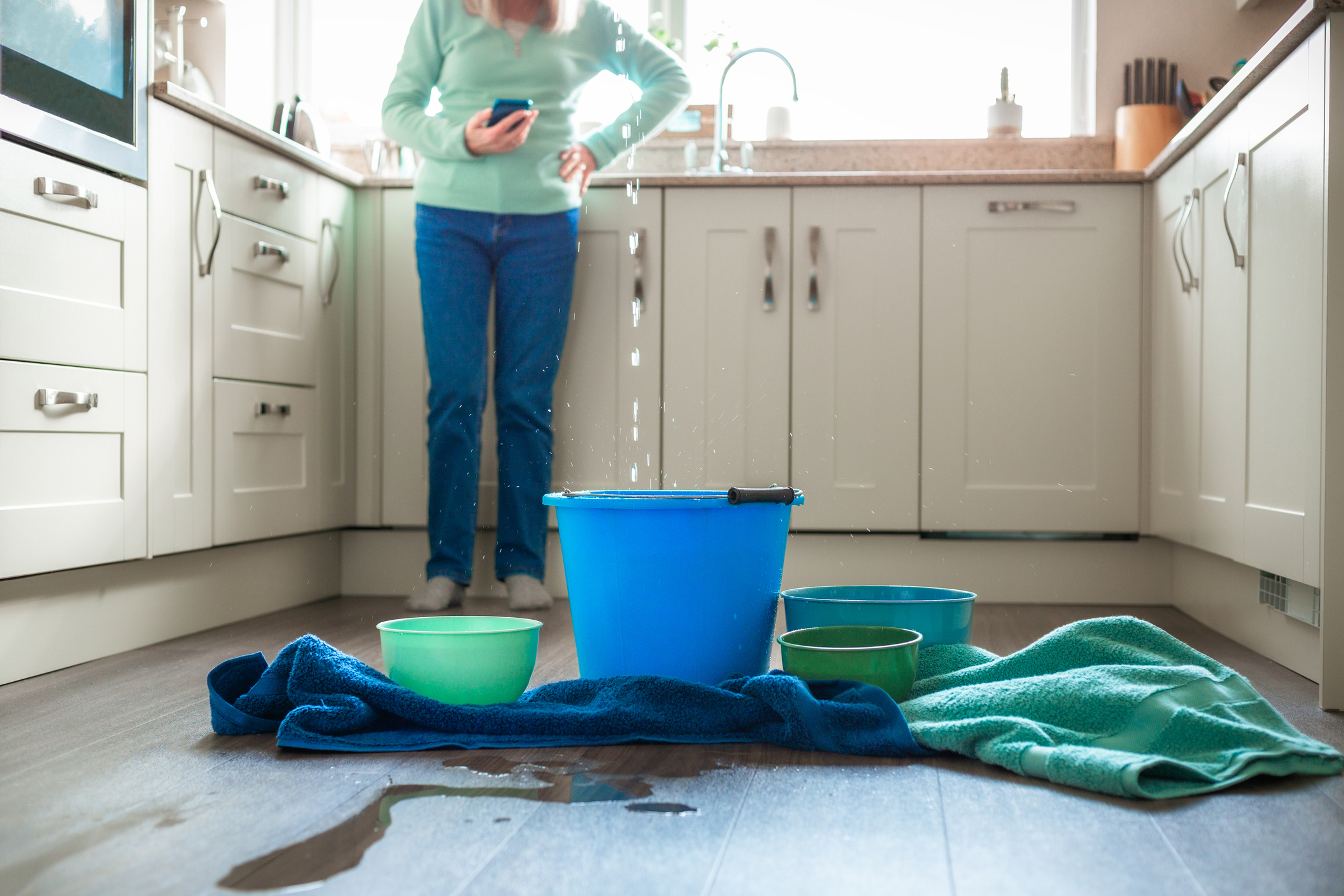Five Water Damage Risks Homeowners Forget About — and Why Insurance Won’t Always Cover Them
Water damage is one of the most common — and costly — home repairs. Here's what your policy may not protect against, and how you can avoid major headaches.

Rachael Green
As both Humberto and Imelda get upgraded to hurricanes, the National Hurricane Center has issued advisories to residents along the Atlantic coast. Even though most models show the stormy pair veering east into the ocean, they're still expected to cause some damage on land.
From dangerous rip currents to flash flooding, Humberto and Imelda could put your home at risk of water damage, even if they don't hit your home directly. And if they do cause damage, there is, unfortunately, a pretty high chance your home insurance won't cover the bill.
As you brace for the two-for-one category 1 storm, here's what you need to do to prepare for a hurricane and prevent water damage around your home. You'll also get information about the supplemental insurance coverage you need to line up before natural disaster strikes.
From just $107.88 $24.99 for Kiplinger Personal Finance
Become a smarter, better informed investor. Subscribe from just $107.88 $24.99, plus get up to 4 Special Issues

Sign up for Kiplinger’s Free Newsletters
Profit and prosper with the best of expert advice on investing, taxes, retirement, personal finance and more - straight to your e-mail.
Profit and prosper with the best of expert advice - straight to your e-mail.
Does home insurance cover water damage?
Your homeowners insurance helps cover many types of damage that may occur to your home, but when it comes to water damage, insurance claims get more complicated.
There are several types of water damage not covered by insurance, so depending on the cause of the damage, you might be fully responsible for the repair costs.
Water damage is a common and often costly home repair. According to the Insurance Information Institute, from 2018 to 2022, the average cost of a water damage claim was $13,954. About one in 60 homes filed a claim for property damage caused by water damage or freezing.
To make sure you’re covered, it’s a good idea to thoroughly read your insurance policy. Look for mentions of the types of water issues that home insurance won’t cover.
Common water issues home insurance won’t cover

While insurance will cover certain types of water damage, there are many common water damage exclusions.
- Gradual Leaks: Home insurance is designed to cover damage that results from unexpected, sudden events, like a burst pipe. Slow, unnoticed leaks from pipes, faucets, appliances or roofs that take place over time are usually considered to be maintenance issues, not sudden accidents. Insurance companies consider these types of gradual leaks to be the homeowner’s responsibility.
- Sewer Backups: A sewer backup, in which water backs up into your home through the plumbing system, can cause thousands of dollars in damage, but most traditional home insurance policies won’t cover sewer backups.
- Flooding: If water from an outside source enters your home, it's considered to be a flood. That includes water that comes from heavy rains, hurricanes, overflowing rivers or snowmelt. Most traditional policies don't include flood insurance, so water entering your home from an outside source isn't covered unless you have a separate flood insurance policy.
- Broken Appliances: If your dishwasher, water heater or washing machine leaks, your insurance may cover the damage if the leak was sudden, such as if the machine unexpectedly broke. But if the machine malfunctioned because of wear and tear or lack of maintenance, your insurance won’t cover the damage.
10 tips to help avoid water damage to your home

There are several ways to actively help prevent water damage to your home.
1. Regularly Inspect Plumbing: Since homeowners insurance won’t cover gradual leaks that are caused by old or poorly maintained plumbing, regularly inspecting your plumbing can help you identify these leaks early on to minimize damage. Look for corrosion or slow leaks in areas under your sink or behind appliances. If you find any issues, promptly have a plumber out to evaluate and fix the leaks.
2. Maintain Your Roof and Gutters: Keep your roof in good repair to protect your home's interior from water damage. Inspect the roof at least twice a year, during the spring and fall, as well as after any heavy storms or strong winds. Promptly repair missing or damaged shingles and trim back any tree branches that could damage your roof. Regularly clean your gutters and keep your downspouts clear to prevent water backup and to channel water away from your home.
3. Install a Water Leak Detection System: A smart leak detector like the Ring Alarm Flood and Freeze Sensor can identify water pooling on a floor and send an alert to your phone so you can quickly address the issue. If you want a more comprehensive solution, an item like the Moen Flo Smart Water Monitor can detect abnormal water usage in your home and shut off the water to prevent leaking and flooding.
4. Maintain Your Sump Pump: Test your sump pump twice a year and before any anticipated big storms or heavy rains. During storms, check your basement frequently to make sure the pump is operating correctly. Consider installing a sump pump with a battery backup system, which can keep the pump operating during power outages. You can also install a sump pump monitoring system, like the Level Sense Sump Pump Monitor, which monitors your sump pump and sends an alert to your phone if it detects an issue, like a high water level.
Keep an eye on leaks indoors or outdoors with the Moen Flo Smart Water Monitor water detector. Features automatic shut-off and seamless integration with your smart home system.
5. Strategically Grade Landscaping: Walk around your home and inspect the grade of your landscaping. Landscaping that slopes toward your home can direct water into your foundation, potentially leading to leaks. Regrade the landscaping so the ground slopes away from your home, directing rainwater and snowmelt away from the foundation.
6. Seal Foundation Cracks: Regularly inspect your basement and foundation walls and floors for any cracks, which could let moisture into your home. You can seal small cracks yourself, but be sure to hire a professional to address larger issues.
7. Maintain Your Appliances: Keep track of the age of your appliances and their required maintenance using a digital calendar or other monitoring system. Replace washing machine and dishwasher hoses every five years, or sooner if they show signs of wear. When you replace them, upgrade to stainless steel braided hoses, which are extra durable.
8. Install a Backwater Valve: A backwater valve helps prevent any water leaving your home through drain pipes from reentering your home. Hire a plumber to install a backwater valve in your home to help prevent sewer backups. Some cities even offer residents rebates to install them, so check with your town hall for any potential savings.
9. Choose Waterproof Materials in Your Home: You can also weatherproof your house through strategic material choice. Consider using water-resistant flooring and sealed surfaces in spaces like basements, kitchens and bathrooms where leaks and moisture could be an issue. If your basement often experiences leaks and moisture, a raised modular flooring tile allows water that gets underneath the tile to quickly dry for a lower-maintenance option. Installing a dehumidifier can also reduce moisture in your basement.
10. Review and Update Your Insurance Coverage: You can buy additional insurance coverage and endorsements to extend your homeowners insurance water damage coverage. For example, some insurance providers offer a sewer back-up endorsement that would cover damage caused if your sewer system backs up into your home. You can also purchase a separate flood insurance policy that would cover damage caused by flood waters, whether that’s from a hurricane or a heavy rainfall. If you’re thinking of buying extra coverage, thoroughly read through the policy and make sure you understand any exclusions.
Use the tool below, in partnership with Bankrate, to explore today's home insurance options:
The best ways to prevent homeowners insurance water damage issues
Since many types of water damage are not covered by insurance, it’s helpful to take an active role in preventing damage from occurring in the first place.
Focusing on maintaining and weatherproofing your home can minimize or prevent water damage and save you money in the long term.
Get more insurance tips and other personal finance insights straight to your inbox. Subscribe to our daily newsletter, A Step Ahead.
Related Content
Profit and prosper with the best of Kiplinger's advice on investing, taxes, retirement, personal finance and much more. Delivered daily. Enter your email in the box and click Sign Me Up.

Paige Cerulli is a freelance journalist and content writer with more than 15 years of experience. She specializes in personal finance, health, and commerce content. Paige majored in English and music performance at Westfield State University and has received numerous awards for her creative nonfiction. Her work has appeared in The U.S. News & World Report, USA Today, GOBankingRates, Top Ten Reviews, TIME Stamped Shopping and more. In her spare time, Paige enjoys horseback riding, photography and playing the flute. Connect with her on LinkedIn.
- Rachael GreenPersonal finance eCommerce writer
-
 Changes Are Coming for This Invesco Bond Fund
Changes Are Coming for This Invesco Bond FundThe Invesco BulletShares 2026 Corporate Bond ETF's bonds will mature in 2026. Here's what investors should do.
-
 What Science Reveals About Money and a Happy Retirement
What Science Reveals About Money and a Happy RetirementWhether you’re still planning or already retired, these research-based insights point the way to your best post-work life.
-
 7 Retirement Planning Trends: What They Mean for You in 2026
7 Retirement Planning Trends: What They Mean for You in 2026From government shutdowns to market swings, the past 12 months have been nothing if not eventful. The key trends can help you improve your own financial plan.
-
 How to Leave Different Amounts to Adult Children Without Causing a Rift
How to Leave Different Amounts to Adult Children Without Causing a RiftHere’s how to leave different amounts to adult children without causing a family rift.
-
 Introducing Your CD's Edgier Cousin: The Market-Linked CD
Introducing Your CD's Edgier Cousin: The Market-Linked CDTraditional CDs are a safe option for savers, but they don't always beat inflation. Should you try their counterparts, market-linked CDs, for better returns?
-
 How to Protect Yourself and Others From a Troubled Adult Child: A Lesson from Real Life
How to Protect Yourself and Others From a Troubled Adult Child: A Lesson from Real LifeThis case of a violent adult son whose parents are in denial is an example of the extreme risks some parents face if they neglect essential safety precautions.
-
 Here's How Much You Can Earn with a $100,000 Jumbo CD
Here's How Much You Can Earn with a $100,000 Jumbo CDYou might be surprised at how fast a jumbo CD helps you reach your goals.
-
 A Financial Planner Takes a Deep Dive Into How Charitable Trusts Benefit You and Your Favorite Charities
A Financial Planner Takes a Deep Dive Into How Charitable Trusts Benefit You and Your Favorite CharitiesThese dual-purpose tools let affluent families combine philanthropic goals with advanced tax planning to generate income, reduce estate taxes and preserve wealth.
-
 How Financial Advisers Can Best Help Widowed and Divorced Women
How Financial Advisers Can Best Help Widowed and Divorced WomenApproaching conversations with empathy and compassion is key to helping them find clarity and confidence and take control of their financial futures.
-
 Your Guide to Buying Art Online
Your Guide to Buying Art OnlineFrom virtual galleries to social media platforms, the internet offers plenty of places to shop for paintings, sculptures and other artwork without breaking the bank.
-
 I'm 59 With $1.7 Million Saved and Just Lost My Job. Should I Retire at 59½, or Find New Work?
I'm 59 With $1.7 Million Saved and Just Lost My Job. Should I Retire at 59½, or Find New Work?We asked professional wealth planners for advice.
